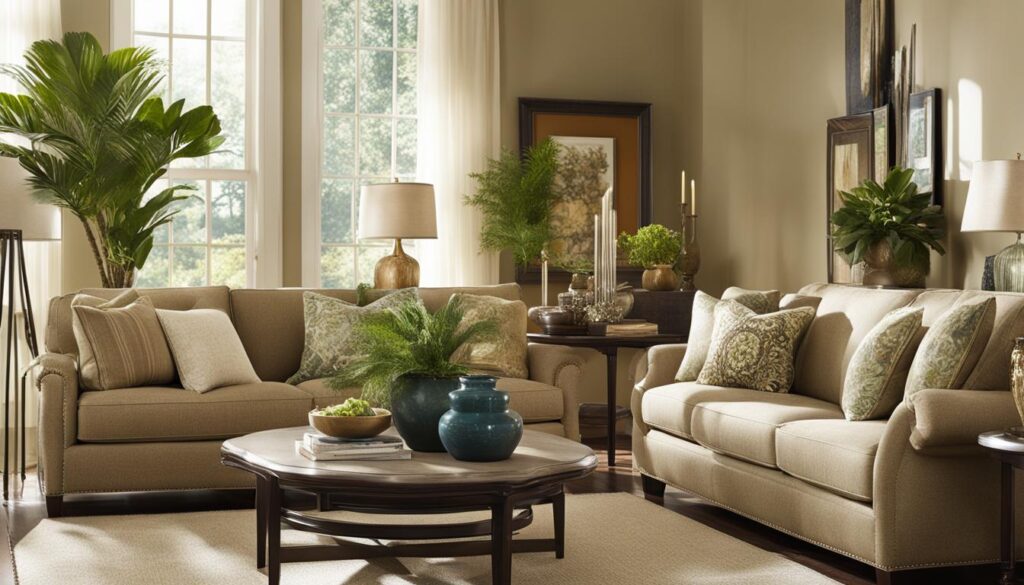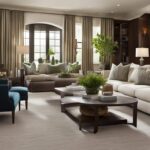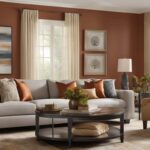When it comes to arranging a living room, there are several factors to consider to create a functional and aesthetically pleasing space. From furniture placement to space planning, designing a living room that meets your needs requires careful thought and organization. In this article, I will provide you with tips and ideas on how to arrange your living room effectively.
Start by considering the shape of your room and its intended use. This will help you determine the best layout and furniture placement. Begin with the largest piece of furniture, such as the sofa, and position it towards the room’s focal point, whether it’s a TV, fireplace, or window.
Next, place smaller seating options, like chairs or love seats, opposite or adjacent to the main piece. Fill the space with accent furniture, such as ottomans, coffee tables, end tables, and lamps, ensuring that each seat is within reach of a tabletop surface.
Avoid pushing all furniture against the walls, as this can create an awkward space in the middle. Instead, pull furniture towards the center to create a more open feeling. Flexibility is key in a living room arrangement, so add lightweight chairs or stools that can be easily moved as needed.
Use a large area rug to unify a seating group within a larger space, making sure all key furniture pieces fit on top of the rug. Strategic furniture arranging can make long or large living rooms feel cozy by dividing the space into two conversation groupings. For conversation-focused living rooms, position the seating pieces close to the middle of the room, facing each other, with a coffee table in the center.
Consider the natural focal point of the room, whether it’s architectural or a TV, and arrange the seating to face it. Traffic flow is important, so make sure there is enough space between furniture pieces for easy movement. Lighting plays a crucial role in any room, so use a mix of overhead lighting, floor lamps, and table lamps to achieve a properly balanced lighting scheme.
To summarize, arranging a living room involves careful consideration of the room’s shape, focal point, furniture size, traffic flow, and lighting. By following these tips and ideas, you can create a functional and aesthetically pleasing living room that suits your needs.
Table of Contents
Key Takeaways:
- Consider the shape of the room and its intended use when arranging your living room.
- Start with the largest piece of furniture and orient it towards the room’s focal point.
- Position smaller seating options opposite or adjacent to the main piece.
- Add accent furniture to fill the space, ensuring that each seat is within reach of a tabletop surface.
- Avoid pushing all furniture against the walls to create a more open feeling.
Creating a Functional Living Room Layout
When it comes to designing a living room layout, functionality should be a top priority. By considering the natural focal point of the room and strategically arranging furniture, you can create a space that not only looks great but also serves its purpose effectively.
Start by identifying the focal point of your living room. This could be a fireplace, a large window with a stunning view, or even a TV. Once you’ve determined the focal point, orient your seating towards it to ensure that it becomes the main focus of the room.
There are several layout options to choose from depending on your space and preferences. For a symmetrical layout, two sofas facing each other separated by a table or a sofa flanked with matching side chairs can create a balanced look. In rooms with many windows, a floating furniture layout can be used, where furniture is floated away from the walls to create an island in the center of the room with a TV mounted on one wall. An L-shaped layout works well for living room and dining room combinations, with the sofa on the long wall and the TV positioned on the wall directly in front of the sofa. Irregularly shaped rooms can be arranged by creating zones using furniture on area rugs, and long narrow rectangular living rooms can have a sofa on one wall and the TV on the opposite wall.
Key Considerations for a Functional Living Room Layout:
- Ensure clear paths and traffic flow between furniture pieces.
- Use large area rugs to anchor seating groups and define separate zones.
- Place side tables or coffee tables within easy reach of every seat.
- Create a balanced lighting scheme with a mix of overhead lighting, floor lamps, and table lamps.
- Hang wall decor strategically in proportion to the furniture.
In summary, a functional living room layout starts with identifying the focal point and arranging furniture in a way that complements it. Consider the size and placement of furniture pieces, traffic flow, and the overall balance of the room. By incorporating these elements and paying attention to details such as lighting and decor, you can create a living room that is both inviting and practical.
| Furniture Layout | Description |
|---|---|
| Symmetrical Layout | Two sofas facing each other separated by a table or a sofa flanked with matching side chairs |
| Floating Layout | Furniture floated away from the walls to create an island in the center of the room with a TV mounted on one wall |
| L-Shaped Layout | Sofa on the long wall with the TV positioned on the wall directly in front of the sofa |
| Zoned Layout | Creating separate zones using furniture on area rugs in irregularly shaped rooms |
| Narrow Rectangular Layout | Sofa on one wall and the TV on the opposite wall in long narrow living rooms |
Conclusion
In conclusion, arranging a living room requires careful consideration of various factors to create a functional and aesthetically pleasing layout. By following the provided tips and guidelines, you can design a space that maximizes its potential and enhances its overall appeal.
When starting the arrangement process, it is important to identify the room’s focal point and orient the furniture towards it. This could be a TV, fireplace, or window. Additionally, positioning smaller seating options, such as chairs or love seats, adjacent or opposite to the main piece of furniture helps create a balanced seating arrangement.
Furthermore, incorporating accent furniture like ottomans, coffee tables, end tables, and lamps adds both functionality and visual interest to the space. It is important to avoid pushing all furniture against the walls, as this can create an awkward and disconnected feeling. Instead, pulling furniture towards the center of the room creates a more open and inviting atmosphere.
Lastly, consider the natural traffic flow within the room, ensure there is enough space between furniture pieces for easy movement, and utilize proper lighting to create a balanced ambiance. By keeping these tips in mind and planning ahead, you can achieve a well-organized living room that suits your lifestyle and design preferences.
FAQ
What should be the focal point when arranging a living room?
The focal point can be a TV, fireplace, or window. Orient the furniture towards the focal point.
How do I create conversation areas in a living room?
Place seating close together and ensure that people can comfortably talk to each other.
How do I balance the size and placement of furniture pieces?
Avoid grouping all large or small pieces in one area and create a sense of order by arranging identical sofas or chairs opposite each other.
How do I maximize functionality in an irregularly shaped living room?
Create zones using furniture on area rugs and ensure that all furniture in a seating arrangement can rest on the rug.
What is the importance of traffic flow in a living room arrangement?
Leave clear paths between furniture pieces for easy movement.
How can I achieve a balanced lighting scheme in a living room?
Use a mix of overhead lighting, floor lamps, and table lamps.
What is the best way to plan the layout of a living room?
Use online tools or graph paper to sketch out the desired floor plan in advance.


